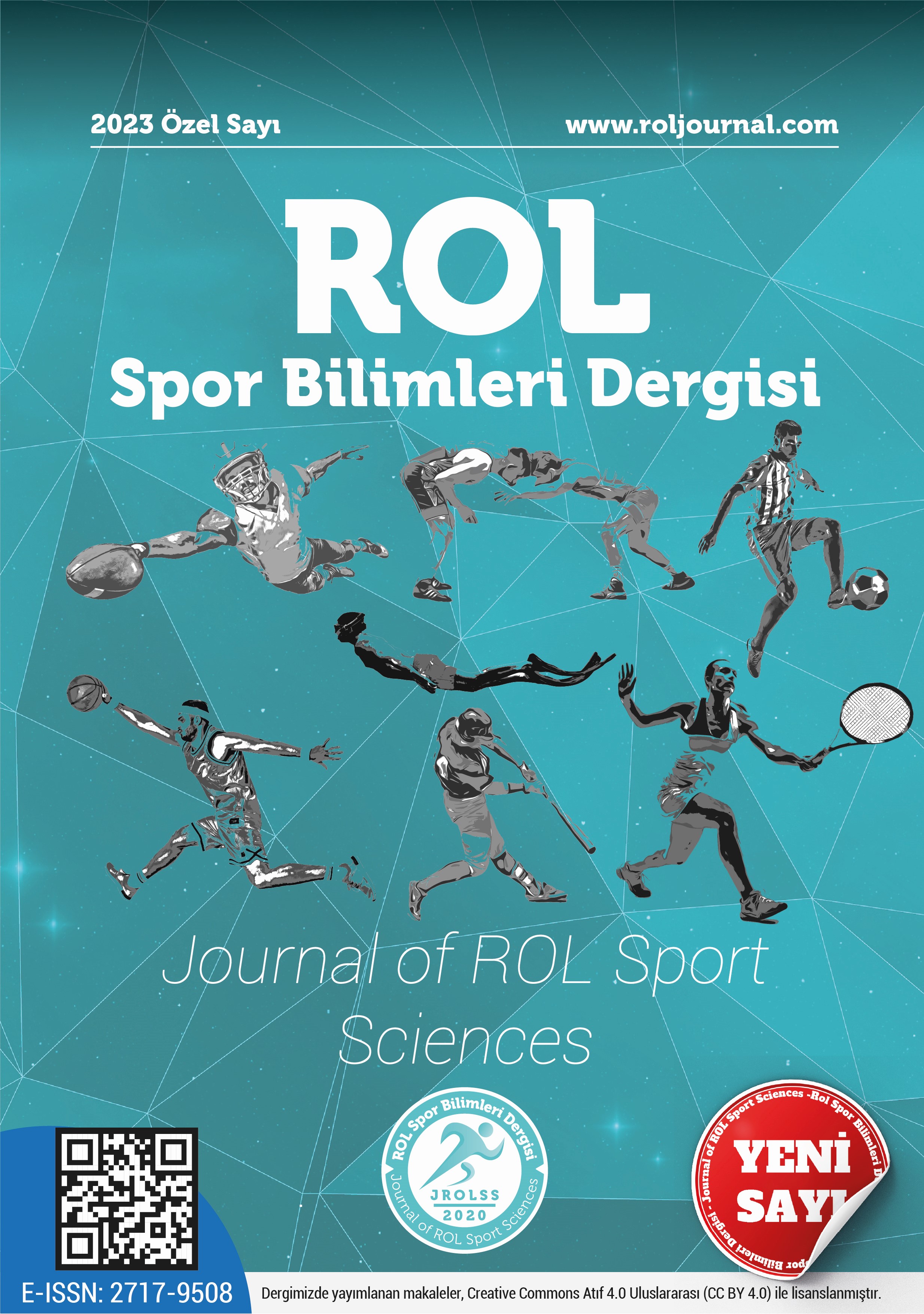Fartlek egzersizlerin adölesan kız basketbolcularda aerobik performans üzerine etkisinin araştırılması
DOI:
https://doi.org/10.5281/zenodo.10036155Anahtar Kelimeler:
Adolesan kızlar, basketbol, fartlek antrenman, VO2maxÖzet
Araştırmamız Fartlek antrenmanların kız basketbolcularda koşu mesafesi ve maksimal oksijen tüketim kapasitesi (VO2max) etkisini tespit etmek amacıyla yapılmıştır. Araştırmamıza çalışma grubu (n:12, yaş ort:14,81) ve kontrol grubu (n=9, yaş ort:14,83) olmak üzere 21 kişi katılmıştır. Çalışmamız da iki grup ön-test son-test modeli kullanılmıştır. Araştırmamızda çalışma grubuna 8 hafta fartlek yöntemi ile koşu egzersizleri yaptırılırken; kontrol grubuna aerobik antrenmanlar uygulanmıştır. Araştırmada sporculardan vücut ağırlığı (VA), boy (cm), beden kütle indeksi (BKI) ölçümlerine ek Balke koşu bandı testi ve VO2max ölçümleri alınmıştır. İstatiksel analizde SPSS 22 programı; örneklem büyüklüğü tespiti için ise G*Power kullanılmıştır. Analiz sonucunda (g:03, α:0,05, β:0,85)18 katılımcının yeterli olacağı bulgusuna ulaşılmıştır. Verilen normal dağılım göstermediği bulgusuna ulaşılmış ve ön test son test karşılaştırılmasında Wilcoxon işaretli sıralar testi; iki farklı grubun ortalamalarının karşılaştırılmasında ise Mann Whitney-U testi kullanılmıştır. Ölçümler sonucunda çalışma grubunda koşu mesafesinde ve maksimal oksijen tüketim kapasitesi (VO2max) son test lehine anlamlı olduğu, kontrol grubunda ise VA, BKI son test değerlerinin ön test değerlerine göre anlamlı düzeyde azalış gösterdiği bulgusuna ulaşılmıştır (p<0,05). Grup ortalamaları karşılaştırıldığında; koşu mesafesi ve VO2max 2. ölçümlerde anlamlı farklılaşma olduğu bulgusuna ulaşılmıştır (p<0,05). Araştırma sonunda fartlek egzersizlerin kız basketbolcularda koşu mesafesi ve VO2max ölçümlerinde anlamlı artışlar olduğu ve dayanıklılık parametrelerine pozitif etki yaptığı sonucuna ulaşılmıştır.
Referanslar
Aadland, E., Solbraa, A. K., Resaland, G. K., Steene-Johannessen, J., Edvardsen, E., Hansen, B. H., … et al. (2017). Reference values for and cross-validation of time to exhaustion on a modified Balke protocol in Norwegian men and women. Scandinavian Journal of Medicine & Science in Sports, 27(11), 1248-1257. https://doi.org/10.1111/sms.12750
Akyol, P., & İmamoğlu, O. (2019). The effects of a three-month exercise on physical fitness, body composition and some blood parameters in sedentary middle-aged female. Journal of Education and Training Studies, 7(11), 63-71. https://doi.org/10.11114/jets.v7i11.4424
Bompa, T., O. (1999)., Periodisation theory and methodology. IL Human kinetics.
Eleckuvan, M., R. (2014). Effectiveness of fartlek training on maximum oxygen consumption and resting pulse rate. International Journal of Physical Education, Fitness and Sports, 3(1),85-88. https://doi.org/10.26524/14115
George, J. D., Paul, S. L., Hyde, A., Bradshaw, D. I., Vehrs, P. R., Hager, R. L., … et al. (2009). Prediction of maximum oxygen uptake using both exercise and non-exercise data. Measurement in Physical Education and Exercise Science, 13(1), 1-12. https://doi.org/10.1080/10913670802609086
Hazar, K., & Hazar, S. (2016). The effect of continuous running and fartlek training on maximal oxygen consumption capacity. Nigde University Journal of Physical Education and Sport Sciences, 3(10), 351-356
Fahmi, B. S., Omar, A. H., & D. Hamid. (2014). The effects of fartlek training in improving cardiorespiratory fitness among elderly. Malaysian Journal of Movement, Health and Exercise. 8(7),58-63
Feasel, C. D., Sandroff, B. M., & Motl, R. W. (2021). Cardiopulmonary exercise testing using the modified Balke protocol in fully ambulatory people with multiple sclerosis. Cardiopulmonary Physical Therapy Journal, 32(2), 57-65. https://doi.org/10.1097/CPT.0000000000000141
Uslu, S., Hindistan, I. E., & Çetin, E. (2022). Determination of maximum oxygen consumption by machine learning methods using step kinematics. Journal of Sport and Performance Research, 13(2), 201-216. https://doi.org/10.17155/omuspd.1097679
Levine, B., D. (2008). VO2max: what do we know, and what do we still need to know? The Journal of Physiology. 586(1), 25-34. https://doi.org/10.1113/jphysiol.2007.147629
Mitchell, R. D., & Crandall, C. (2017). Validation of the 15-minute Balke field test for competitive, adult 5k runners: From treadmill VO2max testing to enhancing performance. American Journal of Sports Science and Medicine, 5(3), 44-47. https://doi.org/10.12691/ajssm-5-3-1
Nambi, G., Abdelbasset, W. K., Agrawal, S. M., Elsayed, S. H., Verma, A., Vellaiyan, A., … et al. (2022). Comparative effectiveness study of low versus high-intensity aerobic training with resistance training in community-dwelling older men with post-COVID-19 sarcopenia: A randomised controlled trial. Clinical Rehabilitation, 36(1), 59-68. https://doi.org/10.1177/02692155211036956
Sarmidi, S. (2018). Effect of fartlek training on the improvement of VO2max on athlete’s runners of 800-metres. in an international seminar on public health and education, Atlantis Press.
Sutanto, Teguh. (2016). Buku pintar olahraga. Pustaka Baru Press
Stojmenović, D., Trunić, N., & Stojmenović, T. (2022). A comparative study of aerobic capacity among elite basketball players according to five different positions in the team. Journal of Physical Education and Sport, 22(10), 2522-2529. https://doi.org/10.7752/jpes.2022.10320
Fauzan, M. A., Sarifin, S., & Setyagraha, E. (2020). Perbandingan latihan interval dan latihan fartlek terhadap VO2max atlet bola basket fik unm (Doctoral dissertation, Unıversıtas Negerı Makassar). http://eprints.unm.ac.id/19754/
Jadhav, R. (2020). Effect of fartlek training on speed and endurance among athletes. International Journal of Multidisciplinary Educational Research, 9(12), 123-129.
Jones A., M. (2016). Sport and exercise physiology testing guidelines. Routledge.
Vasconcelos, T., Hall, A., & Viana, R. (2017). The influence of inspiratory muscle training on lung function in female basketball players- a randomised controlled trial. Porto Biomedical Journal, 3(2), 86-89 https://doi.org/10.1016/j.pbj.2016.12.003
Vickers, R., R. (2003). Measurement error in maximal oxygen uptake tests. Naval Health Research Centre.
Ziv G., & Lidor R. (2009). Physical attributes, physiological characteristics, on-court performances, and nutritional strategies of female and male basketball players. Sports Medicine, 7(39), 547-68. https://doi.org/ 10.2165/00007256-200939070-00003
Puente, C., Abián-Vicén, J., Salinero, J. J., Lara, B., Areces, F., & Del Coso, J. (2017). Caffeine improves basketball performance in experienced basketball players. Nutrients, 9(9), 1033. https://doi.org/10.3390/nu9091033
İndir
Yayınlanmış
Nasıl Atıf Yapılır
Sayı
Bölüm
Lisans
Telif Hakkı (c) 2023 ROL Spor Bilimleri Dergisi

Bu çalışma Creative Commons Attribution 4.0 International License ile lisanslanmıştır.

